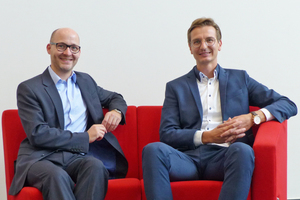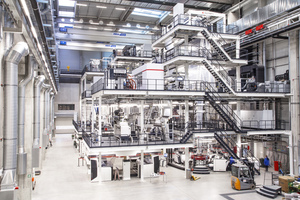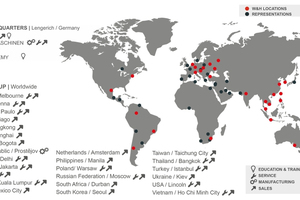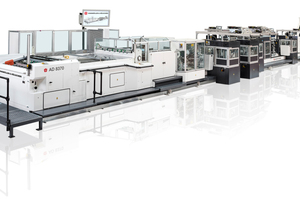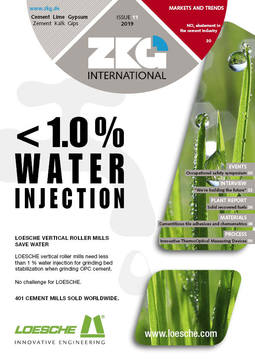We’re building the future – yesterday, today and tomorrow
The machine engineering company Windmöller & Hölscher is celebrating its 150-year anniversary in 2019, and in this anniversary year it is well-equipped to meet future challenges. We spoke to Dr Benedikt Sitte, General Manager Business Unit for Converting Machines, and Dr Dominik Wörsdörfer, Technical Sales & Product Manager, both Windmöller & Hölscher Group, about the innovations W&H wants to introduce to make packaging in the cement industry more sustainable.
At your headquarter in Germany, you are expanding your technology centres. What benefit does the 10000-m² centre for the unit for machines for the production of flexible packaging have for your customers?
B.S.: In our in-house technology centre, our customers can test our machines live on site, and that with their own products or recipes, on original scale. In addition, in the test centre our R&D department tests new trends and researches solutions for future technological challenges. This sets us up very well to maintain our technology leadership, and our customers profit from our experience. We use the centre for training and coaching our customers and employees, too. These training sessions are conducted directly on the machines as part of our W&H Academy events.
Here in Lengerich we have the world’s largest testing centre for machines for the production of flexible packaging.
W&H sees the future topics of digitalization and sustainability as growth drivers for the company. What do your concepts on these look like?
B.S.: In digitalization, “Packaging 4.0” is our key topic. By this we understand intelligent machines with integrated processes and intuitive operation. We are developing our own digital products. The increasing intelligence of the machines thanks to integrated automation and intuitive operation contribute to better control of machine.
D.W.: Regarding sustainability our machines are technologically so advanced that our customers are able to gain minimized material use and hereby save resources in production. In flexible packaging, the creation of a circular economy is currently the challenge for the entire industry. With our machines recycled plastics (regranulates) can already be processed today.
Flexible packaging performs an important protective function and also makes a contribution to environment protection (e.g. Save Food Initiative).
Technology, efficiency, functionality and recyclability must be reconciled. And we also have to support countries that do not have functioning waste management systems yet. There are already good solution approaches in Germany and Europe, in this field we are forerunners. The experience acquired here can be transferred to countries that are not yet as advanced in waste management. W&H joined the European recycling initiative CEFLEX in 2018. CEFLEX is a collaborative initiative of a European consortium of companies and associations representing the entire value chain of flexible packaging. The mission is to further enhance the performance of flexible packaging in the circular economy by designing and advancing better system solutions.
In respect of a circular economy are there already concrete solutions and examples of implementation in flexible packaging?
B.S.: Work is underway on first concrete solutions in CEFLEX. The goal is to present a roadmap in 2020 and establish an infrastructure in 2025. However, that will only work in cooperation with others, and not with just a single player.
In what markets are you particularly active and with which solutions are you impressing your customers in the cement sector?
D.W.: Windmöller & Hölscher is active globally. We address all markets with our portfolio. For the cement industry, we offer the right machine solution for our customers, irrespective of whether this means packaging made of woven, film or paper. The customer decides which packaging material is best suited for his market and we provide the proper machine. Here we also work closely together with other suppliers in packaging for the cement industry.
Paper or plastic sack: Is there an ideal packaging for the cement industry?
B.S.: That always depends on the specific conditions in the markets. These include raw material availability and costs, consumer behaviour/habits, infrastructure and transport, climatic conditions, storage, value of the filling product, filling systems, etc. There are differences in the various markets and therefore no ideal cure-all solution. Our advantage is that we have the entire range in our portfolio and remain neutral in offering the customer the solution best suited for him, irrespective of whether this is paper or plastic sacks.
Your company philosophy is “Passion for innovation”. What future innovations do you see for packaging in the cement industry?
D.W.: Worldwide we see trends in the packaging of cement in the following aspects:
1. Material reduction, two-ply rather than three or four-ply sacks
2. Smaller packages, 25 kg instead of 50 kg
3. Improved sack tightness for protection of employees against dust during the filling process and protection against product losses during transport
B.S.: In the European market, we are registering a particular trend to moisture protection, sustainable solutions, i.e. the use of biodegradable materials (biocoating, recyclable PE interlayer, etc.).
With 8% of your turnover, you are investing a high amount in R&D. How does your long-term planning look?
B.S.: Research and development are an important success factor at W&H and a particular added value for our customers. As a technology leader, we attach great value to a strong and innovative research and development department. Only in this way we can maintain our technology leadership.
//www.wh.grou" target="_blank" >www.wh.grou:www.wh.group/int/en

